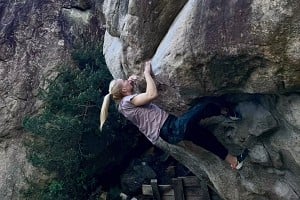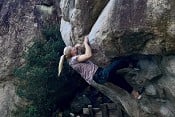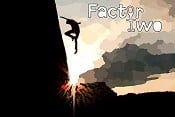
Does anyone have any recommendations for analog cameras that are good for mountaineering?
Ideally something cheapish and not too fragile, with a flash for bivvy shots and a decent focal length.
Spent many years using an OM1n in the mountains. In 1994 in our team of 3 with 5 cameras between us it was the only one still working on the summit of Parchamo. No flash though.
Before going digital I used an Olympus OM1 (SLR) and a Rollei 35b (small compact), both very reliable and robust. The Rollei was very popular as a climber's camera in the 70s & 80s. Both are now in a box under the bed, can't bring myself to sell them although I doubt I'll be using them in the near future.
OLYMPUS MJU-II ticks all the boxes and is quite a nice little camera.
The Olympus XA (28mm, rangefinder focusing) and XA-2 (35mm, three preset focuses) are very pocketable, robust cameras. The flash is an extra though.
T.
Why film? I'm not a camera buff (obvs) so can't see the advantage.
Because its better
To OP - I have an Olympus XA - the range finder focus is tricky with one hand if rock climbing etc but otherwise it's great, I've taken it on lots of big routes.
Rollei 35B or Rollei 35. My climbing camera of choice for many years as a student. Or Olympus Rangefinder cameras: RC 35 and RD 35. Don't have built in flash but dedicated flash units are usually easy to find on fleabay.
I may have an Olympus mjuu that I could find in a draw if your interested
i have just dug out my old Nikon FM2 and bought a Roll of ilford film for my daughter to learn with, I do sort of miss the contemplation required with film
I second the Rollei's for reputation but my Yashica T4 with Ziess lens was small, had automatic rewind and was quite simple to use. The picture quality was excellent and I could easily give illustrated talks on biggish screens with crystal sharp focus/quality.
I remember that Yashica camera; excellent lens capable of equally excellent shots.
This was taken with an Olympus XA-2. Scanned from a slide, but it gives an idea of what might be achieved. https://flic.kr/p/bKkp5n
T.
What do you mean/prefer for a “decent” focal length? Fixed or zoom? For a fixed focal length I prefer wide angle 24mm to 35mm but others think differently. For SLR Pentax MX with 28mm lens,
https://www.ukclimbing.com/images/dbpage.php?id=22543
film compact Ricoh GR1 https://www.ukclimbing.com/images/dbpage.php?id=34882
An Olympus Trip?
I'll second the suggestions of the Olympus XA which was a tiny and very capable camera with a fast lens and a bit more manual control available than most compacts. Sadly, bits of mine are likely still scattered around the base of the Penon...
Thanks for the replies all. Something like the Olympus mju ii zoom 80 looks like it’d work well.
What about a Rollei AFM 35? Rollei lens, made in Germany, built in flash, f2.6/38 mm lens, autofocus or manual focus. Program or aperture priority mode. I've got one for sale if you are interested.
Review here: http://www.photographyreview.com/product/cameras/film-cameras/point-and-sho...
I bought a Mju1 in a charity shop for £1 and am amazed at its quality. No zoom but pin sharp lens.
Thanks for the offer. That looks like a great little camera. I’d rather something cheaper though so that if something happens to it it’s not the end of the world.
Wonderful camera, some very fine memories of mine.
Some of these suggested Rollies and Minox's, etc must be nearly 50 years old. Mine were never 'that' reliable when brand spanking new.
A much more recent climber's classic was the Ricoh GR1v and GR21. But they're not cheap. I've just sold mine on the internet to a buyer in Japan for several times the new price.
having owned several of the cameras mentioned above, certainly most of the Olympus models , I wonder how many people looking at this thread have one lying in a draw somewhere that they can't part with ? I Had two or three mu ju s ( I kept loosing them)and a couple of om1 s . I think you could get a mu ju of ebay for very little Money that would be an excellent choice .
Edit : just had a look on eBay , £20 will get you one .
I'm taking a nikon L35AF this weekend. Super sharp lens, with vignetting in the corners for "that analog look". Has a great flash too.
I have two Olympus XA-1s here in my desk, gathering dust, one with a flash.
I got them off eBay some years ago (got one and 'accidentally' somehow 'won' the other one almost simultaneously) and tried them. I'm not really a proper photographer so I obviously can't make the most of them, but I found the results pretty mediocre and they made me really appreciate digital.
I used a Yashica T4 for climbing and expeditions for many years but looking back at my old slides, I wasted so many shots and only a few are really any good. I have an Olympus Mju II that I bought to replace a lost one, but I've almost never used it.
For 90% of people, especially climbers, I think film is impractical, overrated and purely nostalgia. Digital took off - and excelled - for a reason.
> Something like the Olympus mju ii zoom 80 looks like it’d work well.
I still have one of those! Did a fine job on my trip to Venezuela in 2000. Being supposedly water resistant makes it handy for outdoors work. I was seduced by digital not long after, but when I unearthed some old 35mm colour film in the back of a cupboard a couple of years ago I decided to take some photos "old style" just for the heck of it. Popped the battery back in to the mju and it fired up first time, no problems, and whacked through the cassette in a day. I didn't expect the pictures to be much good due to the age of the film but what did surprise me was the cost of getting it processed. If you're not "into" photography there's no way you'd stomach those prices compared to digital. Even getting prints made from digital originals in a high street shop is cheaper than getting prints from film.
(That's not to say that I've been put off buying some new film and having another go. I'm not much of a one for snapshots so the cost wouldn't be a huge barrier for me. And it might make an interesting change having to wait until I've taken 36 photos, and then the processing time, before I can see the results. If I felt like getting a real nostalgia hit I'd get a Zenit E like I had back in the 1970s, shoot monochrome and process it myself. The camera wouldn't be that costly but the processing kit & materials would likely make a bit of a hole in the credit card.)
I sold my old mid 90s Mju 2 on eBay a few months ago. It was a superb wee camera, but even though it hadn't shot a roll of film since about 2001 it achieved double what it retailed at in the 1st place. Massive bidding war. A real spectacle- think there were 40 bidders and 60 watchers. Crazy.
Have to say though, in terms of things I've punted on that site, that was the most personal item and had the most memories attached. I'll never go back to film but love the feel of the results.
I don't see why anyone would choose a 35mm film (I mean stills!) camera nowadays in preference to digital. When I was shooting mountain landscapes professionally (all in pre-digital days) for my mt landscape books I tried to keep the grain size and sharpness the same, irrespective of the size of the picture in the final book. Thus for full-page and 1 1/4 page pics I would use 6 x 6 Hasselblad shots. For double page spreads I would use either 2 Hasselblad frames joined in the gutter, or a Fuji 690 shot, or (ideally) a 5 x 4 large format (Wista view camera) shot. For single-page cropped 'portrait' shots or 3/4 page shots I would use a 645 Fuji camera. I would very occasionally use a Nikon 35mm camera (FM2 or FE, with highest quality fixed Nikkor lenses) but then the pictures could never be used for anything larger than a 1/2 page shot i.e (a 1/4 of a double page) or smaller, because the quality was just not high enough alongside the medium and large format images. I think there's only about half a dozen 35mm shots in all my books.
Another vote for Ricoh GR1v (mine is about to be for sale), Yashica T4, and Rollei 35B (my first camera, excellent lens for the price but mine is definitely not up for sale). FM2 can't compete on size and convenience for rock climbing in my view.
Not used an OM1 but I was impressed by the pics shot on one, in extremis, in Simon MacCartney's "The Bond".
In case anyone wasn't sure what perfectionism means... And what it can accomplish.
More interesting insights into the thinking, planning and preparation that went into those wonderful books. Thanks for posting.
I wonder if it's because they're looking at repro in books? Having loads of mountain and photo books on my shelves it's notable that the repro in the recent digital books is very rarely up to the same quality of those shot on film. I suppose this is partly due to the tighter budgets nowadays, but also the demise of the 'closed-loop' system where the operators always used the same workflow from scanner to press and only had to cope with a handful of films. Digital input and workflow is far less controlled, though magazines seem to handle it better. Poor digital colour was the main reason I kept shooting film.
On books produced from a mix of film and digital (e.g. Great Mountain Crags of Scotland) the shots from digital compacts really stand out as being poorer in quality than the 35mm shots, despite supposedly higher resolution that probably looks fine on screen. Film images degraded by grain and diffraction repro far better than digital images affected by pixelation and noise. The same factors affect books by people like Joe Cornish, so it's clearly not just operator error. However in many cases it's true that you wouldn't have got an image at all in the same conditions on film.
Small sensors are still very much a mixed bag in terms of quality. I think it will be a long time before the average compact carried by a climber repros as well as 35mm, and in the meantime we've got a big chunk of time in which most of the recent historical record looks pretty poor in print.
As a contrast to Gordon's wonderful photography, and accepting that in this case the pictures weren't taken for the same purpose, it's worth looking at another book that may feature on a number of bookshelves round here; Granite and Grit by Ronald Turnbull. There are some excellent illustrations, especially the line drawing, and some of the photos too; but not all, not by a good way. A number of them seem to have been blown up beyond the limit at which they were, presumably, scanned from slide or print and have a fuzzy out-of-focus appearance which really does no favours to a picture-rich book.
So from a very different position, that of 'consumer' rather than an author, I'm agreeing with Gordon. 35 mm film or slide had its place back in the day, and for some still does; and I remember using the cameras I owned with great fondness, especially the XA-2 I mentioned earlier in the thread. If 35 mm cameras are your thing then I hope you enjoy them and value the experience as much as I and many others once did; but for almost everyone else, a digital camera makes much more sense.
T.
> Does anyone have any recommendations for analog cameras that are good for mountaineering?
> Ideally something cheapish and not too fragile, with a flash for bivvy shots and a decent focal length.
Olympus Mju II, if the prices were not so inflated now. I would probably just go for any cheaper, decent compact from the 90s. If you could do without flash, or don't mind a clip-on, an older Olympus Trip 35 might be good too.
No doubt, digital now offers better image quality than film, it is more convenient, and in the long run it's cheaper. For most purposes, I use digital and would not be without it. However, in the past year I have started shooting film again, 35mm and medium format. It's not about absolute image quality; for me it is about a different process. Yes, it's expensive, and I am lucky if I get four or five frames I really like from a roll, but I enjoy the process of taking photos on film more than I do digital. I suppose you could compare it to losing half your skin jamming up a gritstone crack when there is a perfectly good path to the top of the crag.
The photo of Squareface on p1 of Classic Rock 2007 was taken on an XA2.
I have a Yashica 165 zoom compact practically mint , full kit including remote control gadget.
Probably one of the biggest zooms ever put on a pre digital compact, obviously a bit bulkier than a T4/5 but Yashica quality always has a bit of the Contax kudos for me...
If you want it it's yours for postage and a small contribution to the cancer charity of your choice.
Alan Hinkes used an Olympus 35RC and later a Ricoh 500 and GR1. I scanned all of his slides for the 8000m book and the quality is fine for that coffee table publication. A good drum scan produces something pretty impressive from 35mm. That Alan also used slide film and got such good exposures at such altitude is a testament to combination of camera and operator. The lens on the Ricoh is stunningly sharp too.
Have a look at a couple of samples of Alan's scans at the bottom of this article...
https://www.onlandscape.co.uk/2014/12/36-megapixels-vs-6x7-velvia/
> Does anyone have any recommendations for analog cameras that are good for mountaineering?
> Ideally something cheapish and not too fragile, with a flash for bivvy shots and a decent focal length.
People need more criteria. Does it need to be lightweight? Does it need to be operable one-handed with gloves on? What sort of mountaineering? What sort of photos do you want (this governs the focal length)?
Without answers to any of the above, I'd say Olympus Mju II, BUT it has its limitations.
Someone mentioned Nikon LC35 which is a good call but considerably heavier than the Olympus.
Theoretically the Pentax PC35AF (or the -M version of same) should be a great winter mountaineering 35mm camera, I have one and it stacks up nicely in competition with the LC35, but honestly I've never actually taken it in the mountains to use in anger.
Personally I've never got on with the Olympus XA series. Fiddly and a bit annoying. I know people have had brilliant results from them, so I am not knocking the actual cameras, only reporting my experience.
If you want a bit of zoom (as everything I mentioned is single-focal-length), look at the Pentax ESPIO 105SW, a very underrated camera.
Personally I think some of the available zoom ranges like 35-80mm are a waste of time, weight and space. This Pentax with a wide angle of 28mm, is much better. It's also a lovely camera and has a very useful "Bulb mode with flash" allowing a bit of interesting creativity.
There is a version that goes to 120mm but it is harder to find and costs more.
You seem budget-conscious so I won't (except I will) mention the Fujifilm Zoom Date aka Silvi (24mm-50mm) - not an amazing zoom range and the lens is slow at 50mm but that 24mm is useful (albeit with vignetting) and it has shutter release buttons on left and right which might be useful. f/2.8 at 24mm.
I got one for £25 from Oxfam. They fetch £110+ on ebay!
Thanks for the replies all. Lots of interesting suggestions. After lots of fun internet window shopping I decided to push the boat out a bit and have gone for a Ricoh GR1S. It should arrive in the next few days and I'm off to Cham in a week so I'll let you know how it goes.
-Mike








